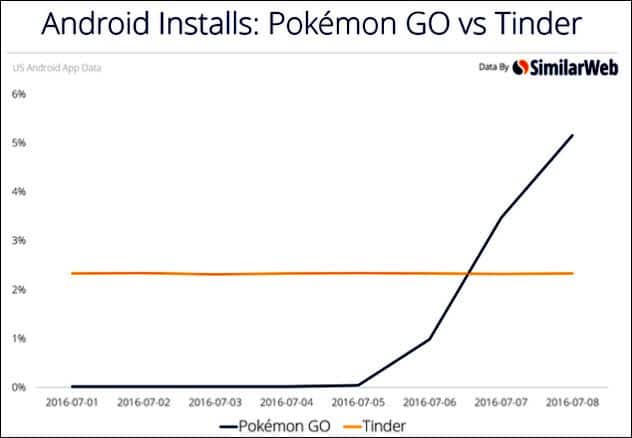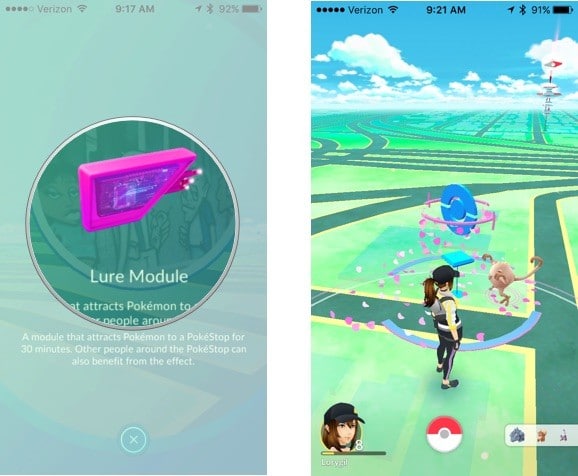Pokemon GO and Local Advertising
With the explosive popularity of Pokemon GO, it definitely leads marketers to wonder how the app can be a factor in local advertising initiatives.
In a matter of days, Pokemon GO has taken the world by storm, shifted a lot of popular paradigms and brought augmented reality to the forefront of everyday life. That’s a pretty impressive checklist, and it’s not all. Estimates suggest that Nintendo’s stock surge has led to the company valuation being up nearly $11 billion, and daily usage time for the app is higher than WhatsApp, Instagram, Snapchat and Messenger, and while installs of Tinder – another location-based application – have been flat, Pokemon GO installs on Android have surpassed it significantly (see the graph below). So what does this all mean for marketers and, more specifically, local advertising?

Image Credit: SimilarWeb
For the first time, the now-tired expression of local-mobile-social has become a reality that can be leveraged by marketers, and it will surely be expanding from here. It is still early to make any definitive claims as to how Pokemon GO and local advertising will work together, but there are already some brands jumping on the opportunity, and there have been hints as to what marketers can expect in terms of ad opportunities. Here are a few confirmed strategies and predictions.
‘Luring’ Clients
You might have heard a few of the not-so-pleasant stories of criminals using the app to attract people to a specific location, then proceeding to rob them. There will always be bad apples out there, and one can only assume that after this story broke, increasing security measures (in some way) became a (if not the) top priority. But the ability to lure players to a specific spot is a great tool when it comes to marketing.

Image Credit: iMore
If you’re using Pokemon GO and you find that a PokeStop is close to your business (or request that one be created around your business) leverage the ‘Lure Module’. This will increase the frequency of Pokemon around your location and certainly lead to increased foot traffic while that is happening. From there, you can offer discounts and specials to players as they pass by your business. (Catching Pokemon is tiring work after all!) Find out how to use your ‘Lure Module’ here.
Building Relationships
One of the most incredible things about Pokemon GO (and one of the reasons why we note that it really does transcend that local-mobile-social triad) is the fact that virtual relationships can transfer into real-life connections around the game (in a Gym, for example, where you might battle another player).
Brand humanization has long been a cornerstone of a successful social business strategy. Combining elements like the Lure and engaging in a game with a prospective customer (or creating a space in a store, for example, that doubles as a Gym and welcomes players from the area) creates an entirely new method of driving real traffic and building real relationships.
Sponsored PokeStops
This is a no-brainer. It shouldn’t be more than a few months before every major brand has found a way to leverage the augmented reality feature with brand prominently featured in the application. McDonald’s is already in talks to find a way to become a part of the phenomenon, and other brands are surely in talks with the developers as well.
As to what will be involved in Sponsored PokeStops and gyms remains to be seen, but there are sure to be methods used by these brands to drive up both traffic, brand awareness and, of course, sales. Which brings us to our next point…
Pokemon GO Specials
When it comes to local advertising, there is no easier way to appeal to your audience than by talking to them in their language, and offering them products, services and discounts based on their tastes and preferences. In this case, those tastes and preferences are almost certainly going to be Pokemon GO related.
We have already started to see a few examples creep up of stores and pop-up locations taking advantage of the foot traffic, but it certainly won’t be all that long before in-game integrations, offers, coupons, bonuses, etc. become available for brands to purchase and take advantage of in order to drive up direct conversions from the app.
Conclusion
20 years ago, Pokemon was the most popular game for children, teens and young adults. You would be hard pressed to find someone between the ages of 7 and 30 that wasn’t playing or at least very familiar with the game. Now, for the first time ever there is a product on the market with uniform affinity across the entire 18-49 demographic. That has never happened before and it helps explain this unprecedented growth.
We’re sure to see lots of creative uses of the app and a major expansion of the product once it comes time for monetization. It will be exciting to watch it grow!



